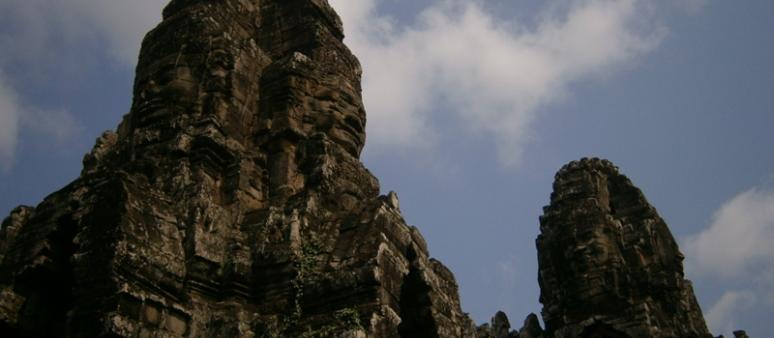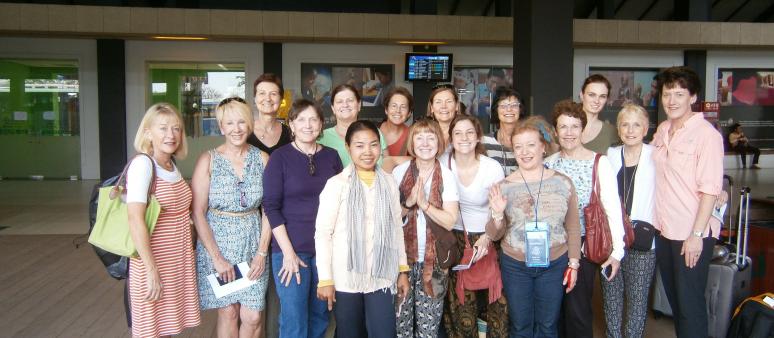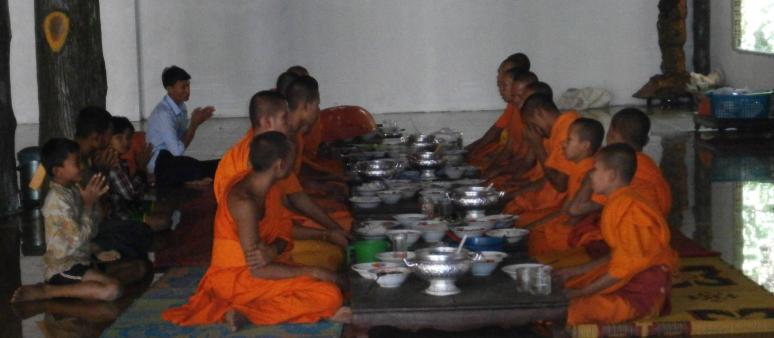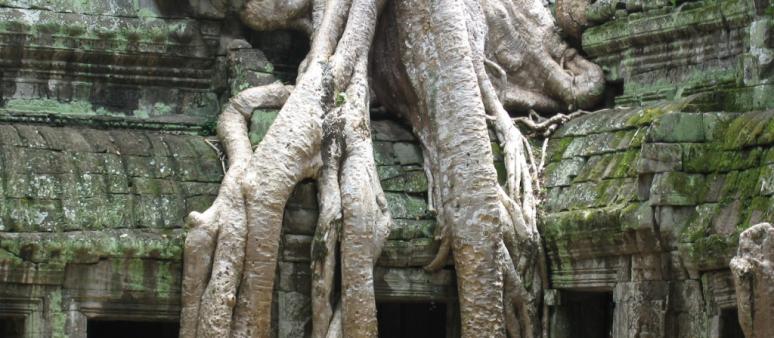Visual arts of Cambodia
The history of visual arts in Cambodia stretches back centuries to ancient crafts. Traditional Cambodian arts and crafts include textiles, non-textile weaving, silversmithing, stone carving, lacquerware, ceramics, wat murals, and kite-making. Beginning in the mid-20th century, a tradition of modern art began in Cambodia, though in the later 20th century both traditional and modern arts declined for several reasons, including the killing of artists by theKhmer Rouge. The country has experienced a recent artistic revival due to increased support from governments, NGOs, and foreign tourists.
History of Cambodian Art and Handcraft
The history of Cambodian art stretches back centuries to ancient pottery, silk weaving, andstone carving. The height of Khmer art occurred during the Angkor period; much of the era's stone carving and architecture survives to the present. In pre-colonial Cambodia, art and crafts were generally produced either by rural non-specialists for practical use or by skilled artists producing works for the Royal Palace. In modern Cambodia, many artistic traditions entered a period of decline or even ceased to be practiced, but the country has experienced a recent artistic revival as the tourist market has increased and governments and NGOs have contributed to the preservation of Cambodian culture.
Textiles
There are two main types of Cambodian weaving. The ikat technique (Khmer: chong kiet), which produces patterned fabric, is quite complex. To create patterns, weavers tie and dye portions of weft yarn before weaving begins. Patterns are diverse and vary by region; common motifs include lattice, stars, and spots.
The second weaving technique, unique to Cambodia, is called "uneven twill". It yields single or two-color fabrics, which are produced by weaving three threads so that the "color of one thread dominates on one side of the fabric, while the two others determine the colour on the reverse side." Traditionally, Cambodian textiles have employed natural dyes. Red dye comes from lac insect nests, blue dye from indigo, yellow and green dye from prohut bark, and black dye from ebony bark.
Non-textile weaving
Many Cambodian farmers weave baskets (Khmer: tbanh kantrak) for household use or as a supplemental source of income. Most baskets are many of thinly cut bamboo. Regions known for basketry include Siem Reap and Kampong Cham. Mat weaving (tbanh kantuel) is a common seasonal occupation. They are most commonly made from reeds, either left a natural tan color or dyed in deep jewel tones. The region of Cambodia best-known for mat weaving is the Mekong floodplain, especially around Lvea Em district. Mats are commonly laid out for guests and are important building materials for homes. Wicker and rattan crafts (tbanh kanchoeu) made from dryandra trees are also significant. Common wicker and rattan products include walls, mats, furniture, and other household items.
Stone carving
During the late 20th century, however, efforts to restore Angkor resulted in a new demand for skilled stone carvers to replace missing or damaged pieces, and a new tradition of stone carving is arising to meet this need. Most modern carving is traditional-style, but some carvers are experimenting with contemporary designs. Interest is also renewing for using stone carving in modern wats. Modern carvings are typically made from Banteay Meanchey sandstone, though stone from Pursat and Kompong Thom is also used.
Lacquerware
Silversmithing
Silversmithing in Cambodia dates back centuries. The Royal Palace traditionally patronized silversmiths' workshops, and silversmiths remain concentrated at Kompong Luong, near the former royal capital Oudong. Silver was made into a variety of items, including weaponry, coins, ceremonial objects used in funerary and religious rituals, and betel boxes. During Cambodia's colonial period, artisans at the School of Fine Art produced celebrated silverwork, and by the late 1930s there were more than 600 silversmiths. Today, silverwork is popular for boxes, jewellery, and souvenir items; these are often adorned with fruit, fire, and Angkor-inspired motifs. Men produce most of the forms for such work, but women often complete the intricate filigree.
Ceramics
Cambodian pottery traditions date to 5000 BCE. Ceramics were mostly used for domestic purposes such as holding food and water. There is no evidence that Khmer ceramics were ever exported, though ceramics were imported from elsewhere in Asia beginning in the 10th century. Ceramics in the shape of birds, elephants, rabbits, and other animals were popular between the 11th and 13th centuries.
Potting traditionally was done either on a pottery wheel or using shaping tools such as paddles and anvils. Firing was done in clay kilns, which could reach temperatures of 1,000–1,200 °C, or in the open air, at temperatures of around 700 °C. Primarily green and brown glazes were used. In rural Cambodia, traditional pottery methods remained. Many pieces are hand-turned and fired on an open fire without glaze. The country's major center for pottery is Kompong Chhnang Province.
In modern Cambodia, the art of glazed ceramics faded into oblivion: the technique of stoneware stop to be used around 14th century, at the end of Angkor era. Today this technique begin a slow revival through a Belgian ceramist who founded the Khmer Ceramics Revival Center, in Siem Reap, the organization lead vocational training and researches about this lost skill.
Wat murals
Portion of a 1903–1904 mural in Phnom Penh's Silver Pagoda
Because of destruction during recent war, few historic wat murals remain in Cambodia. In the 1960s, art historians Guy and Jacqueline Nafilyan photographed 19th-century murals, providing a record of this lost cultural heritage. The best known surviving murals are at the Silver Pagoda in Phnom Penh, Wat Rajabo in Siem Reap province, and Wat Kompong Tralach Leu in Kompong Chhnang Province. In the last decade, wat murals have seen a resurgence, but Cambodia's surviving older murals are generally more refined and detailed.
Also, a Stegosaurus is depicted in a little picture on the Angkor Wat. There has been speculation about Stegosaurus being known in Cambodian mythology. According to one story, Vishnu actually fought a creature that is said to have a spiked tail, plates on its back, an elephant shaped body, and a little head when it was attacking a little village. Stegosaurus seems to fit this description, but dinosaurs went extinct millions of years ago, suggesting that Vishnu actually fought a surviving Stegosaurus from the Jurassic period. Most people discount this information as a fake, as some people believe that Vishnu may have actually fought a weird-looking serpent.







.jpg)

